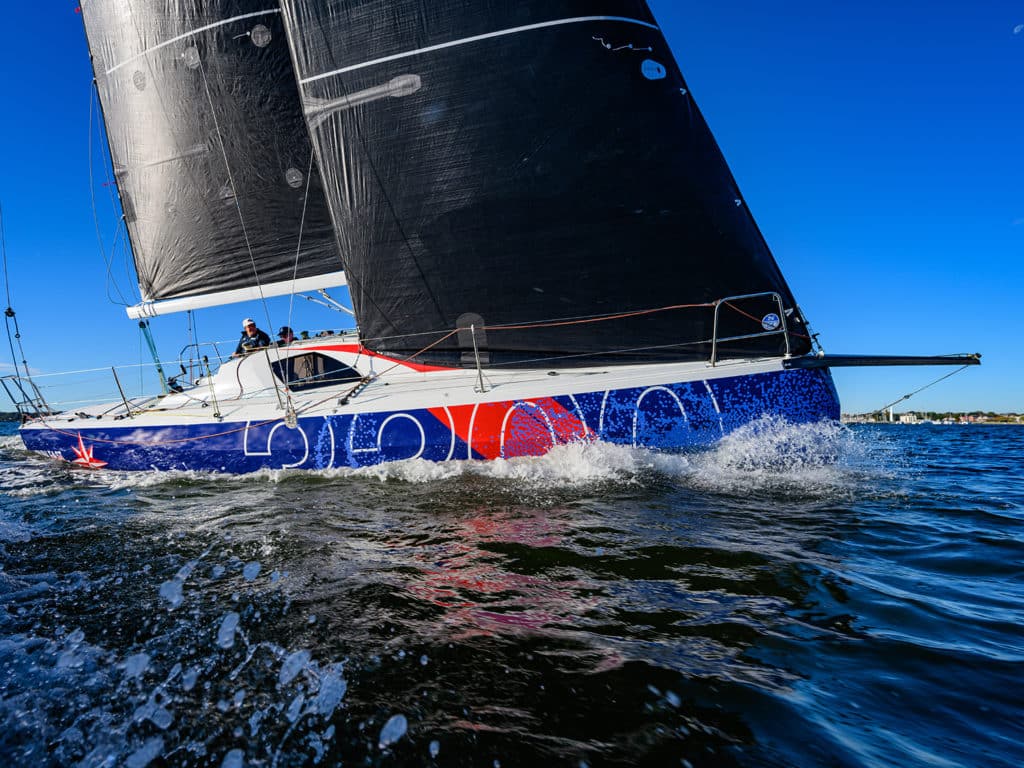
At A Glance
Price As Sailed: $260,000
Design Purpose: Shorthanded or crewed point‑to‑point racing
Crew List: Two to six
Dave Powlison’s feet are wedged into the stainless-steel foot brace. He has a light grip on the tiller handle in his right hand. His gaze is forward, over the shoulders of his mainsail trimmer beside him, then travels over the backs of three big guys sitting comfortably on the rail and out of his sightline. The boat is perfectly balanced. Fifteen knots of wind on a flat bay is the sweet spot for this 32-footer under the seat of his pants. He’s entranced, and you can tell because his forward hand floats midair, digits outstretched as if their tips are feeling the wind direction and heel angle. In this moment, Powlison likes this boat a lot. It’s his frontrunner for Boat of the Year.
“When I was on the helm, I just wanted to be on it for much longer,” he says. “I would have enjoyed sailing it all day.”
For shorthanded offshore aspirants, Powlison’s sentiment should be all you need to hear, because when there’s only you and the autopilot for the next 48 hours, a balanced helm will be all yours to enjoy.
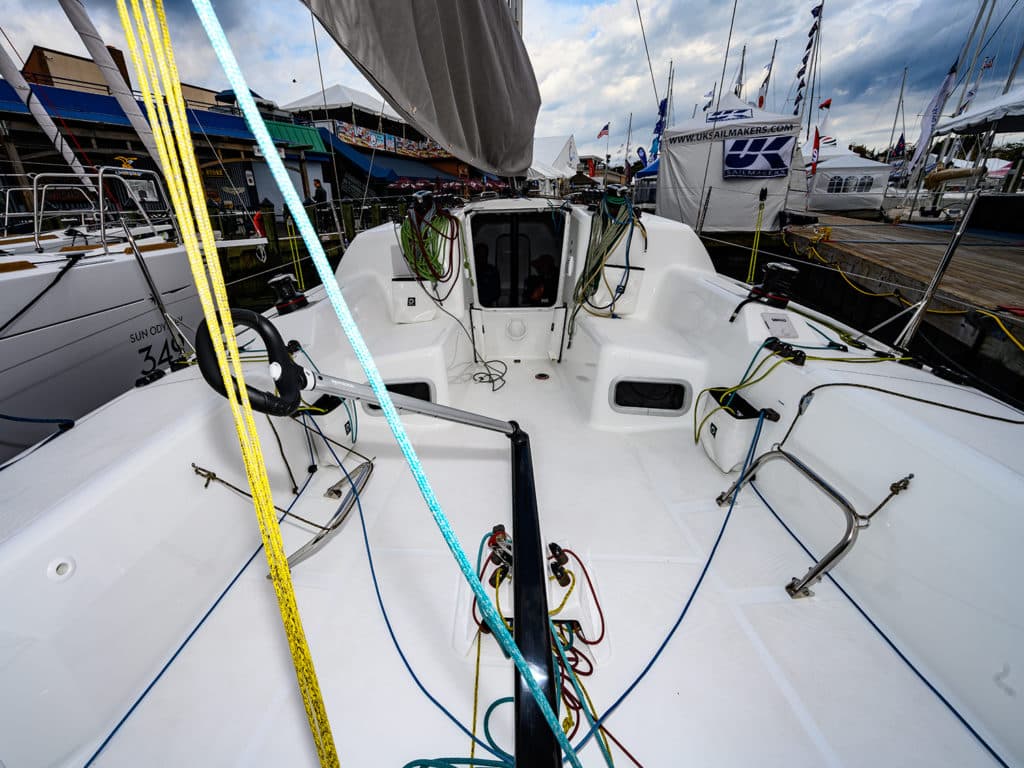
Greg Stewart—the naval architect of our BOTY panel—specializes in underwater appendages and knows balance when he feels it. “What impressed me most was the upwind sailing,” he says. “The balanced ends were really nice. It’s not excessively wide in the back, but the biggest thing is all the volume forward. It’s comfortable to hike and all that tumblehome gives you a lot of interior volume and buoyancy when you press the boat hard. It’s a fun and lively boat to sail.”
Beneath the red, white and blue vinyl wrap, the Sun Fast 3300 is a remarkable hull form, drafted by Jeanneau’s Daniel Andrieu and Guillaume Verdier, designer of the wicked 100-footer Comanche and a long list of fast boats. The hull shape can best be described as powerful, and most definitely designed for the big-deal races in Europe.
Jeanneau’s Mike Coe says the boat targets the shorthanded scene and might someday be considered a candidate for the 2024 Olympic offshore discipline, but in the meantime, the big event for new owners is the doublehanded Transquadra Race, from France to Martinique. In Europe, Coe says, it’s all about windy, downwind races, but for North America, the right boat has to get upwind, in light air too.
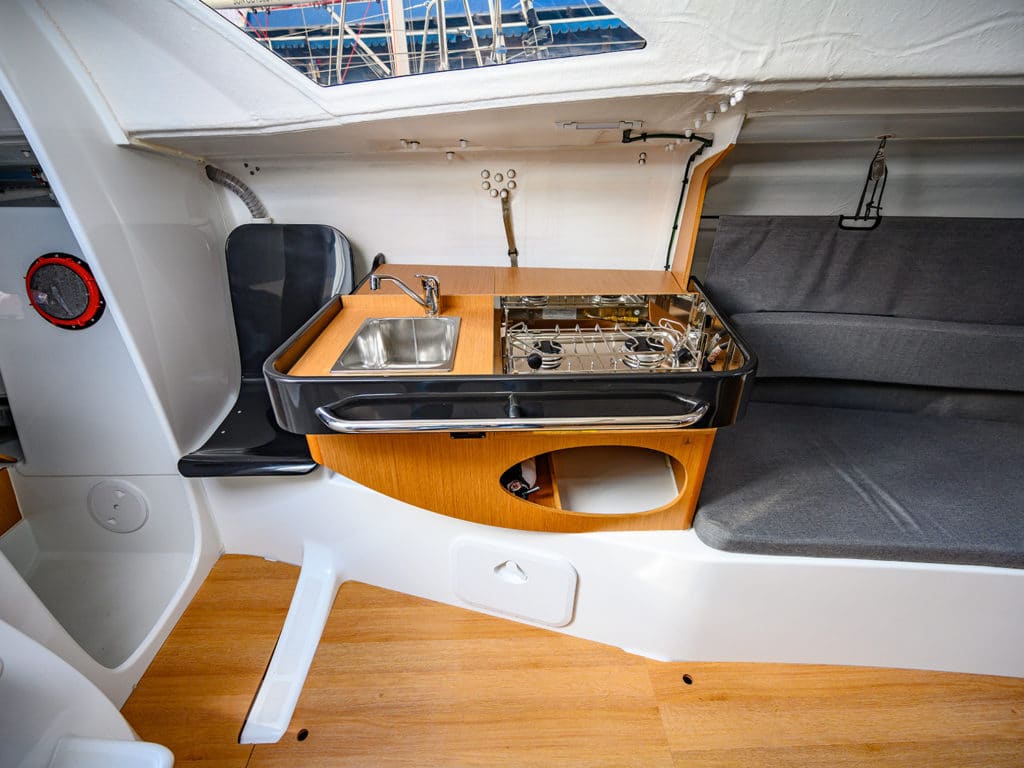
With a carbon rig and a big sail plan, the Sun Fast 3300, he says, is more than capable. And this is where Verdier’s clever thinking comes into play: In particular are curved hollows, referred to as concaves, on centerline. There’s one at the bow and one at the stern. In light air, Coe explains, when you want the stern to stop dragging, you sink the bow a bit. “In heavy air, especially downwind, the stern just kind of sinks onto the concave and induces planing. The boat just sort of grips and rips along.”
So foreign were the concaves to Coe, that when he first saw the boat in jack stands at the boatyard when it arrived, his reaction was that they’d accidentally dented the hull. Not so.
For the hyperactive shorthanded sailor, there are plenty of adjustments to tweak as conditions change: fine-tuning, water ballast, a five- to six-sail inventory and a three-dimensional jib-lead system, among other things. But such tweak-ability does result in piles of rope at your feet in the cockpit, the judges point out. It’s the nature of the beast.
However, where there are ropes, there’s much work to be done in shorthanded sailing, so the pit area at the companionway is both a busy and happy place. While your partner is getting pelted at the helm, you can tether in, take a slightly protected seat and play the sails or nod off in your foul-weather gear. It’s only an overnighter anyway.
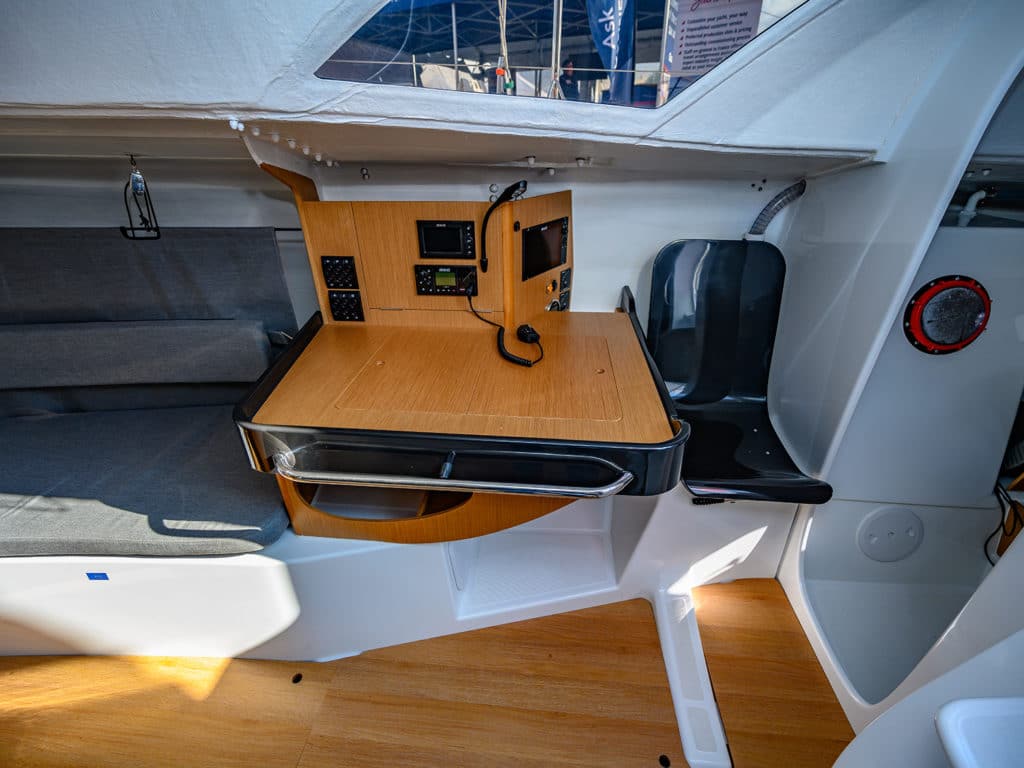
To get out of the weather completely, climb a few steps down the companionway and take in the view through either of the large forward-facing windows built into the cabin top. While the autopilot is engaged, you can cook or navigate while keeping tabs on sail trim and an eye to leeward. There’s not much glitz belowdecks, the judges say, but that’s the point. The 3300 is no crossover cruiser. Inside the bowels of this white Vinylester-infused capsule are nothing but rudimentary accommodations: galley, nav station, convertible settees and aft berths that fold up to add additional pipe berths.
“A lot of people end up buying boats with too much interior and wish they could get rid of it once they start racing it,” Stewart says. “With this boat, you’ll never have to worry, because you’re not buying it in the first place.”
If distance racing and putting the boat away wet is what you desire, he says, this is the level of interior you’ll come to appreciate. Forward, inside the pointy end, is the head and plenty of space for some of your sail inventory, which would include two spinnakers in turtles, code zero on a furler and two hanked jibs. The carbon rig is deck-stepped, which makes the boat easier to ship by container, Coe says, a nod to its consideration as a 2024 Olympics-worthy contender.
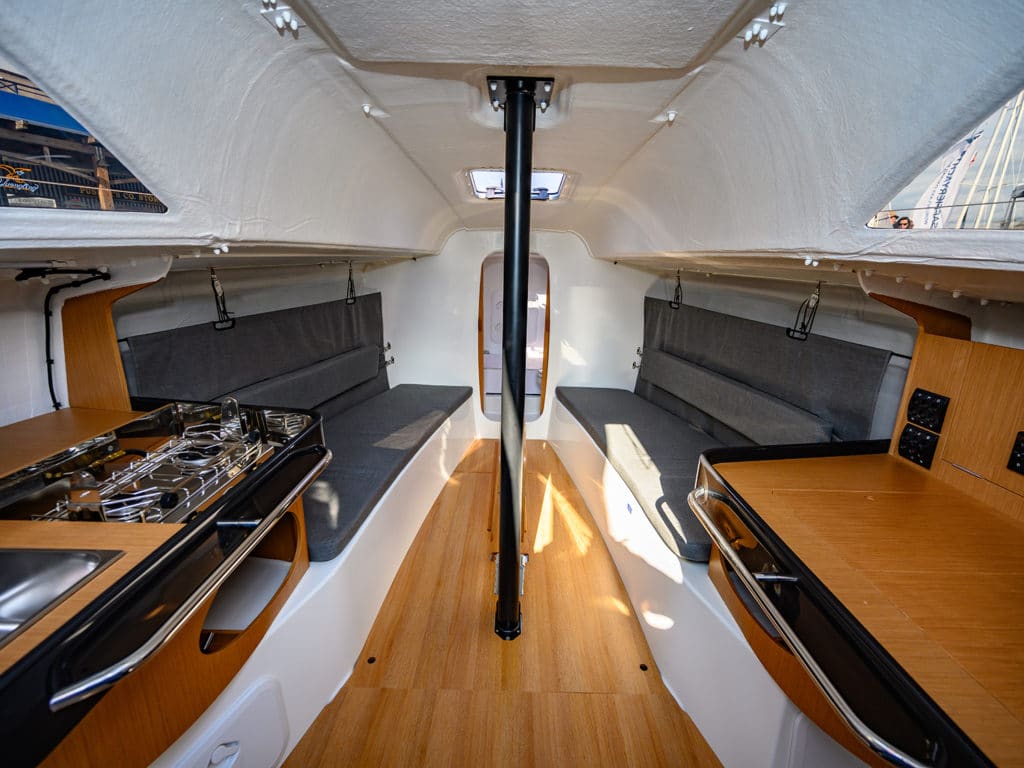
“The keel head is a bow tie shape that goes into a socket in the bottom of the boat really easily,” he says. “The sprit bolts on and the rig is short, so it all packs into a container neatly.”
Coe had raced the boat in a doublehanded overnighter on the Chesapeake Bay a few weeks before its Boat of the Year appearance, and while he and his teammate, Cate Terhune, allegedly got caught on the wrong side of a 180-degree shift in the middle of the night, they paced well in a race that was all upwind, some of it light. They never got a chance to savor the 3300’s sweet spot. Thankfully, the judges did for their test sail.
“It’s all set up right and would be a great boat for anyone wanting to get into doublehanded racing. It hits its design purpose perfectly, the hull shape is innovative, it’s well-built; and it was a ton of fun to sail.” —Chuck Allen
“The helm has a lot of bite, upwind and down,” is judge Chuck Allen’s takeaway. He’s a longtime sailmaker, senior BOTY judge, and predictably the first guy to grab the helm. “I tried a bunch of times to try to wipe it out. It never came close. But it could be sticky in light air. It has a lot of wetted surface, so you have to pay attention to where the weight is and use those hollows. You can tell it likes to reach, and it definitely likes more wind.”
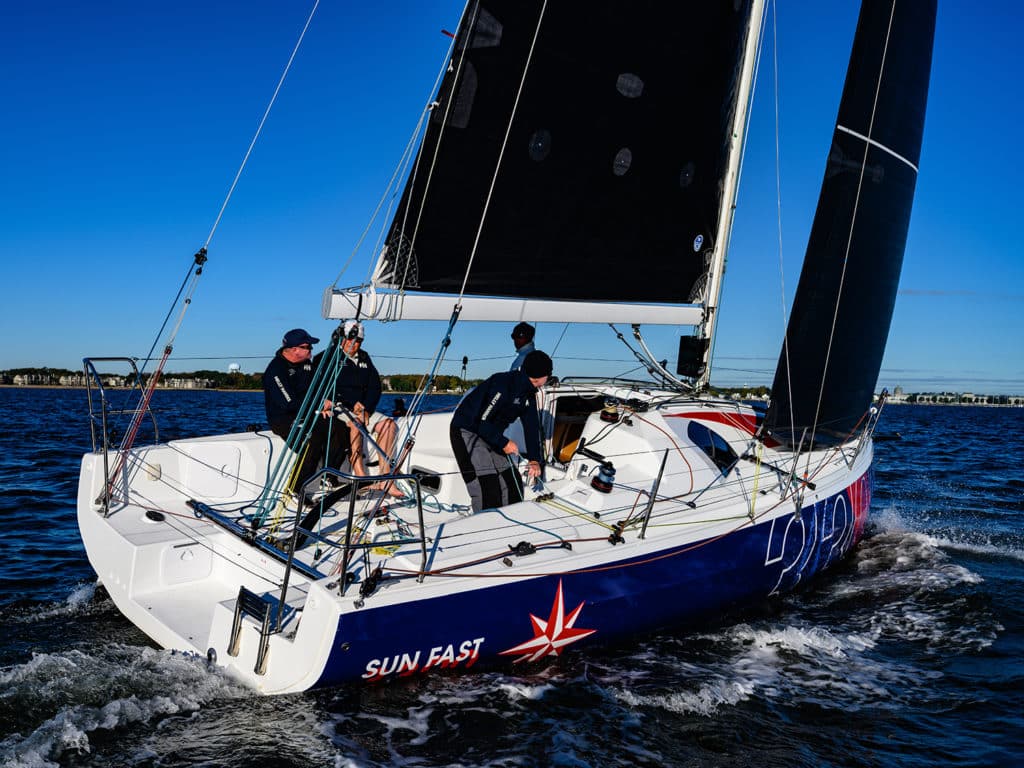
There are plenty of sail controls that will allow crews to stay dynamic with sail trim and boathandling. “You’ve got three-dimensional jib trim, and everything is led right; it’s all easy to get to,” Allen says. “Upwind, the main likes to be above centerline to get a bit of heel angle going, and downwind you can sail fairly deep in any type of breeze. Outside jibes for doublehanding will be no problem.”
There are fine-tune cascades for the running backstays and the mainsheet, as well as the water-ballast system should you need additional righting moment. Port and starboard fill-and-dump buttons are mounted right at the companionway, and in less than a minute, the pump will top off the 52-gallon tank. (There is no transfer system between the two.) That’s the equivalent of about 430 pounds of crew weight on the rail.
While ideal for rank-and-file shorthanded American sailors, Powlison’s take on this clear choice for Boat of Year is that it’s not necessarily a beginner’s race yacht. “It’s a sophisticated boat that’s set up really well for a pair or team of accomplished sailors,” he says. “And like I said, it’s was the one boat I just wanted to keep sailing.”
See All Winners
Other Winners:









